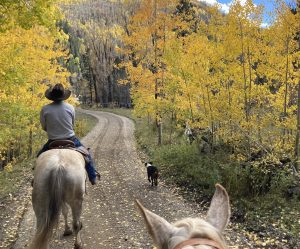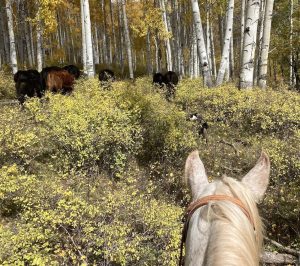 Editor’s Note: An edited version of this essay appeared in the Washington Post. Read below for an alternate and expanded piece.
Editor’s Note: An edited version of this essay appeared in the Washington Post. Read below for an alternate and expanded piece.
By Maddy Butcher
Yellowstone’s fourth season opens with livestock agent Kayce Dutton in a shootout. This is silly, of course. But as it happens, I’ve had my own experience with a gun-wielding brand inspector, another ranch-related job. We were at Cattle Drive Coffee along Colorado highway 160 when a driver from Arizona hit a deer. Joel Stevenson, who had just stopped by, tracked the injured buck and ended his suffering.
Guns are handy. Ropes are essential, so it’s curious that Yellowstone cowboys don’t carry them on their saddles. Such a lapse might be why actual cowboys get a chuckle out of the show.
“I think it might be a decent story line,” said Mark Lundy, lead-off cowboy at the Little Horn Ranch in Montana. “The general public probably enjoys it. But working cowboys critique it and laugh because it’s not real close to the real thing.”
 From Yellowstone to Power of the Dog, the West is getting a lot of attention lately. Yet representations are disappointing and cringe-worthy: cowboys and ranchers are wealthy, violent, uncooperative, and intransigent. Others are simpletons, kicking gravel in the road. The men (and they are mostly men) are unwaveringly tall, brusque, reactive.
From Yellowstone to Power of the Dog, the West is getting a lot of attention lately. Yet representations are disappointing and cringe-worthy: cowboys and ranchers are wealthy, violent, uncooperative, and intransigent. Others are simpletons, kicking gravel in the road. The men (and they are mostly men) are unwaveringly tall, brusque, reactive.
Through observation and conversation, I don’t know many like this. I do know plenty of short, thoughtful, polite men and women with leathered hands and weathered faces. They are white, Black, neither. They are straight or not. Some are progressive; others are more conservative. Many have broken bodies from wrecks, hard living, or both. Like their animals, most are cooperative and lean faithfully towards getting along.
 They number one million at most, according to the USDA Agricultural census. (The Working Ranch Cowboy Association estimates it to be closer to 600,000). One third are women. On average, they make less than $30,000, most without health insurance. Some work on homesteads. Others travel from outfit to outfit.
They number one million at most, according to the USDA Agricultural census. (The Working Ranch Cowboy Association estimates it to be closer to 600,000). One third are women. On average, they make less than $30,000, most without health insurance. Some work on homesteads. Others travel from outfit to outfit.
Before landing at the Little Horn, Lundy was at the Winecup Gambrel, which spans across about a million acres in Nevada. The 36-year old has cowboyed and led cowboys in Oregon, Idaho, and California, too.
Justin Reichert, 49, quit school at 16 and has cowboyed in Kansas, Idaho, Nevada, Arizona, Wyoming, Oklahoma, and Colorado. Most recently, he is responsible for many hundred head on nearly 100,000 acres (more than double to size of Washington, D.C.) near Creede, Colorado. From May to October, he lives mostly alone in a fifth wheel near the Rio Grande National Forest.
“Clocking in and clocking out is not our reality,” he told me. “You could have a four-hour day or a 24-hour day. You might ride at a walk for five hours and then in no time be in a life-or-death situation.”
 “We step up on a 1,200-pound animal and head out into the wilderness. All kinds of things can go wrong,” said his partner, Nicole Grady.
“We step up on a 1,200-pound animal and head out into the wilderness. All kinds of things can go wrong,” said his partner, Nicole Grady.
Something went wrong for Pete Reinholz, who cowboys on the Crow Reservation in Montana. When he came to, he was alone and wasn’t sure what happened. He made it to an emergency room, where they treated his broken nose, broken eye socket, broken cheekbone. They stitched his eyelid back together and told him to take 12 weeks off. He was riding the next day.
“It could have been way worse,” he said.
Cowboys, often alone and truly remote, may be prone to poetry and songwriting. They gather, celebrate, and compete at events like the Outside Circle Show, which Reichert and Grady organize, at the Working Ranch Cowboy Association championship, and the Lone Star Cowboy Poetry Gathering. It’s at events like these where the word “family” crosses lips.
Joe Morris of Morris Grassfed in San Juan Batista reflected of his fellow cattlemen, “they tend to be phenomenally sensitive people. Very closely tied to the rhythms of the land, very close to the processes.”
 There is an intimacy between the four species: human, canine, equine, bovine. It’s quiet and near constant.
There is an intimacy between the four species: human, canine, equine, bovine. It’s quiet and near constant.
On most days, everything – from MacGyverism to the weather challenges and aloneness, to this multi-species animalistic connection (which Benedict Cumberbatch observed while training for his Power of the Dog roll) – deviates from today’s typical work experiences.
Photographer Kurt Markus, who grew up in Montana and now lives in New Mexico, said, “cowboys, I decided, cowboy as an escape from boredom – not theirs, but the emptiness ringing in the rest of American’s ears, the vacuum of not yielding to the turn of the season and the feel of a promising colt between the legs.”
So how to accurately portray the cowboy way?
Start with leftover coffee and chew the grounds between your teeth. Eat something for the long day ahead. Get a handle on the weather. Ready your dogs and horse. You may not see the cows, but because you know the country, the weather, and how cattle think, you can guess where they are and where they’re headed. Then again, the whiff of better grass or the movement of predators might have shifted their course overnight. This is big country.
A day might entail moving a hundred cows and calves across a busy state road, with only the help of your dog. It might include tagging a newborn calf as your horse shields you from its cow.
It might involve navigating up a narrow canyon with two hundred head. As thunderclouds build, you struggle to keep them moving and then need to regather them when four-wheelers barge through the drive.
“It’s a box of chocolates,” said Reichert.
If they are trending on social media, it’s unlikely those folks are living much of this kind of life.
Trinity Seely cowboyed for the Seiben Live Stock Company before heading to California. I asked her what she’d share online if she had the time and inclination: “People need to see the value and joy in the hard day of work. The reward is the long, hard day.”
I like this longer version! Well said, Maddy!